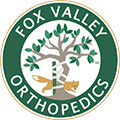Osgood-Schlatter Disease
- Category: General
- Posted On:
- Written By: Kevan E. Ketterling, MD

Osgood-Schlatter disease is indeed an impressive sounding ailment. The name brings to mind exotic illness and many patients tend to confuse it with Hodgkin’s disease, a form of cancer. In reality, Osgood-Schlatter disease is a very common and benign variety of overuse injury that occurs in knees of adolescents. It is related to growth of the bones and thus occurs only in athletes who have not yet finished growing.
Osgood-Schlatter disease refers to pain, swelling and inflammation about the tibial tubercle. This is the bump on the front of the shin bone (or tibia) where the kneecap tendon (or patellar tendon) attaches. Force from the strong muscles in the front of the thigh is transmitted through this attachment to straighten the knee. The tibial tubercle is also the site of a growth plate. This is an area of cartilage where bone growth occurs. The growth plate cartilage is weaker than the underlying bone and the tendon attached to it.
When the forces across the knee are greater than the muscles can accommodate, the growth plate is pulled away from the underlying bone. This results in the pain, swelling and inflammation which characterize the disease. Activity exacerbates the pain, particularly running, kneeling, squatting and jumping. Often pain occurs in both knees. As with other overuse type injuries, symptoms are more common at the beginning of a new season, or after a sudden increase in training intensity.
Osgood-Schlatter disease most commonly occurs between the ages of 11 and 15, and is more common in boys. This is a time of rapid bone growth, which may contribute to the problem. The bones grow so fast that the muscles and tendons are unable to keep up. This leads to a lack of flexibility and strength, which increases stress on the tibial tubercle.
When an athlete presents with Osgood-Schlatter disease, x-rays are usually necessary to rule out more serious problems such as tumors or infection. Additionally, x-rays may show small extra pieces of bone forming in the patellar tendon where the growth plate cartilage has been pulled away from the underlying bone.
Treatment begins with a short period of rest and methods to reduce the inflammation, such as ice and inflammatory medications. A rehab exercise program is then begun, emphasizing flexibility and strength, particularly in the quadriceps muscles. A brace which decreases the force on the tibial tubercle is often useful to keep the athlete competing. The goal of treatment is control of the symptoms until growth is finished since once the growth plate has fused to the underlying bone, the problem resolves.
Emphasizing pre-season conditioning can help to prevent development of Osgood-Schlatter disease. Incorporating stretching to increase flexibility into the work-out routine is also important. Lastly, it is important to recognize that in adolescent athletes organized team sports may be only a portion of their overall activity. Gym class, sandlot sports, and even play activities may contribute to overuse injury.


